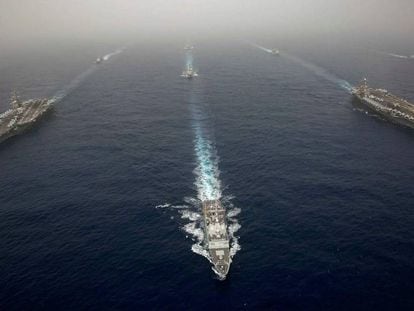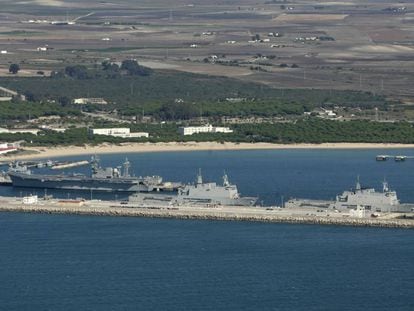Spain accepts more US troops at Cádiz naval base without redrafting defense pact
Government sources say this step was bypassed, given the difficulty involved with modifying the agreement in the current climate in Spain of political uncertainty


The Spanish government has given the green light to the United States to increase its military presence at the Rota Naval Base in the southern Spanish province of Cádiz. But unlike on previous occasions, it has approved the deployment without redrafting the bilateral defense agreement between Spain and the US.
Government sources admit that it chose to bypass this step given the difficulty involved with modifying the agreement in the current climate of political uncertainty, with a new government yet to be formed after the inconclusive results of the April 28 general election.
The current agreement dates back to 1988 and many aspects of it are now outdated
On June 4, the headquarters of the United States 6th Fleet, which is based in Naples (Italy), announced that the four currently deployed guided-missile destroyers at the Rota Naval Base would be replaced between the beginning of 2020 and the spring of 2022. According to military sources, the four vessels (USS Carney, USS Donald Cook, USS Porter and USS Ross), which were made at the end of the last century and arrived in Rota between 2014 and 2015, will be replaced by more modern ships of the same Arleigh Burke class, and be equipped with helicopters.
In a press release, the 6th Fleet announced “additionally, the US Navy intends to relocate a helicopter maritime strike squadron (HSM) to Rota, Spain, in support of the destroyers, which will enhance the multi-mission roles of these ships.”
Military sources indicated that this squadron includes up to six Sikorsky SH-60 Seahawk helicopters (one per ship, plus two in reserve), an older but similar type of helicopter used on the frigates of the Spanish Navy.
The US Navy intends to relocate a helicopter maritime strike squadron to Rota, Spain
United States 6th Fleet
Relocating the helicopters to Rota however, means deploying 30 US troops, including pilots and mechanics, who are not accounted for in the current defense agreement. Under the existing pact, a maximum of 4,250 soldiers and 1,000 US citizens are allowed at the Rota Naval Base, as well as four ships, up to 36 planes and different support systems, such as a communication station, security company and bureaucratic organisms.
The agreement dates back to 1988 and many aspects of it are now outdated. Over the past three decades, consecutive Spanish governments have refused to review the deal in depth, and instead have amended it every time Washington has asked to increase its military presence. This is what happened in 2002, when the government regulated the presence of the US Navy and Air Force information services; and in 2012, when it authorized the deployment of four destroyers and their 1,200-strong crew.
In this case, the Spanish government has not even amended the deal, given that any changes would have to be approved by Spanish Congress and the Senate, and put to parliamentary debate at a moment when the government is still serving in an acting capacity. Instead it chose to interpret the helicopter squadron as part of the four destroyers, which had already been approved.
Under the existing pact, a maximum of 4,250 soldiers and 1,000 US citizens are allowed at the Rota Naval Base
Sources told EL PAÍS that the principal mission of the new vessels will remain the same as those already deployed: “To contribute to ballistic missile defense,” as part of NATO missile defense program.
But the currently deployed destroyers have spent more time on other tasks such as navigating the Black Sea to intimidate Russia after it annexed the Crimean Peninsula, and supporting operations in Syria. In April 2017, the USS Porter and USS Ross launched 59 Tomahawk missiles against a Syrian airbase in response to the Syrian government’s chemical-weapons attack.
The authorization to increase US troop numbers at the Rota Naval Base comes after Spain decided to pull out the frigate Méndez Núñez from a US-led naval group in the Persian Gulf, a decision which caused tension with the United States. But according to the 6th Fleet, this latest agreement highlights the “enduring relationship between the US Navy and our Spanish naval allies.”
English version by Melissa Kitson.












































